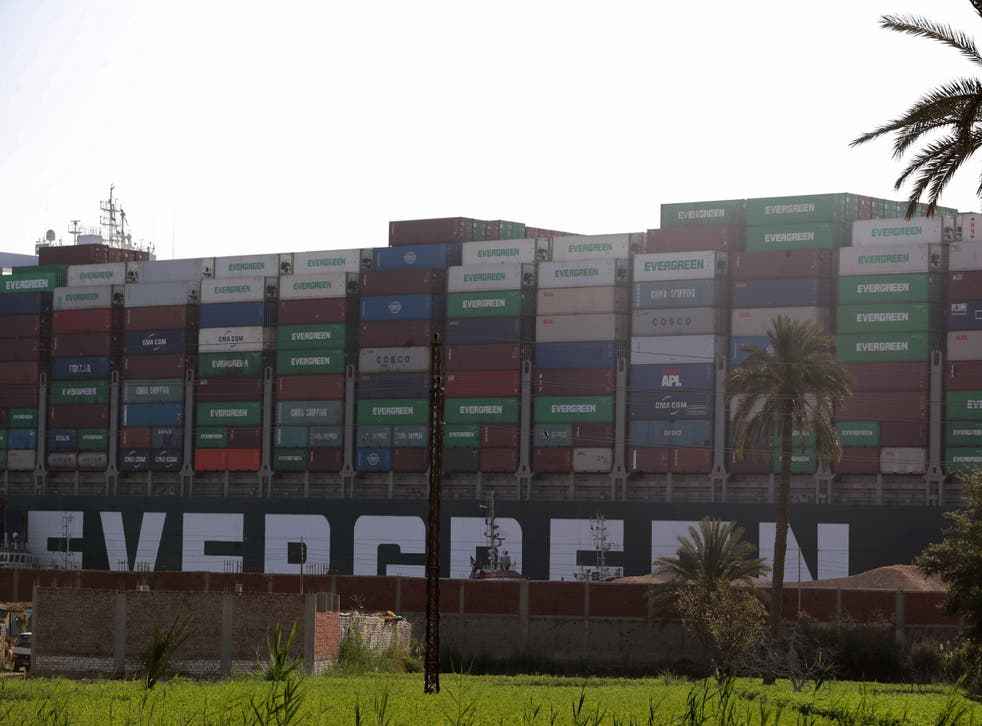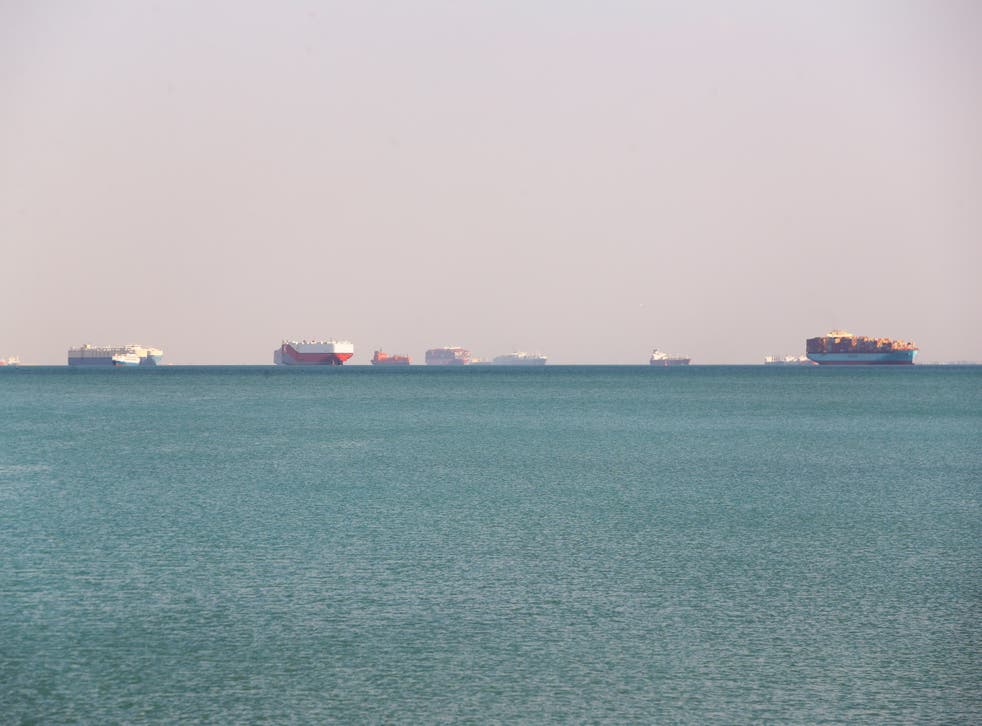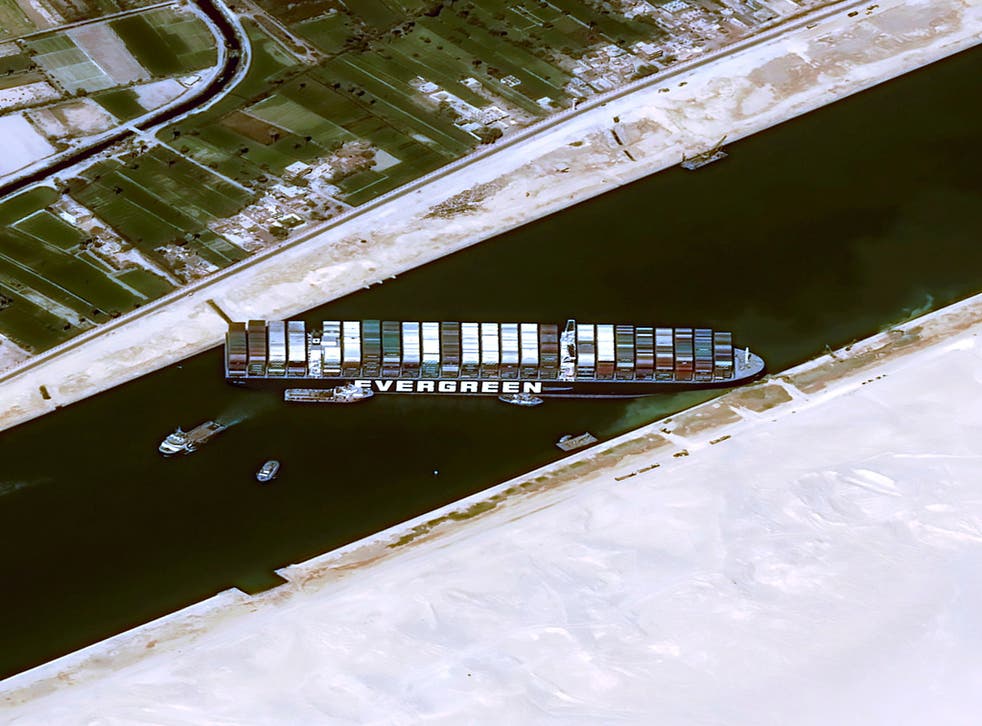‘Every day there’s another backlog, these ships are sitting there at risk’
Borzou Daragahi
International Correspondent@borzou
3/26/2021

Going nowhere: Stranded container ship Ever Given
(Reuters)
There is a technical term for the 250 or so tankers loaded with billions of dollars worth of goods stuck on either side of Egypt’s Suez Canal in one of the most politically volatile and unstable regions of the world.
“We would call them sitting ducks,” said Joshua Hutchinson, general manager ARX Mouldings, a UK-based maritime security consultancy.
The quarter-mile long MV Ever Given container ship that ran aground on Tuesday within the Suez Canal has held up billions of dollars worth of global commerce and has already driven up the price of oil, potentially hampering recovery of a world economy already battered by the impact of the Covid-19 pandemic.
On Thursday, Egypt suspended all navigation within the canal as engineering teams from the Netherlands and Japan sought a way to dislodge the gigantic container ship and clear the waterway.
But security experts are also worried about the potential for piracy, politically motivated sabotage, or even more mishaps as scores of massive freight ships remain stuck in two of the most volatile regions on the planet: the eastern Mediterranean and the Horn of Africa.
Read more:
Everything we know about the ship grounded in the Suez Canal
A brief history of the Suez Canal
Log on to any marine traffic monitoring website and you can see icons representing vessels on either side of the canal, in the Red Sea at the southern edge of the Canal or off the coast of Port Said to the north. Further off in the seas more ships slow down, contemplating the roadblock up ahead, and perhaps reconsidering the far lengthier route through open waters around the southern tip of Africa.
“Every day there’s another backlog, these ships are sitting there at risk,” said Mr Hutchinson. “It’s the largest traffic jam the world is about to see. If you’re a static ship, you’re obviously facing a clear threat.”
Any incident could have an impact on the fragile global economy. Rates for transporting containers between Asia and Europe have risen dramatically over the past year. An attack of any type could raise costs further by increasing insurance rates, escalating prices for everything from petroleum to iPhones.

Container ships waiting outside the Suez Canal
(Reuters)
Turned off by the threat of piracy off the coast of Somalia and buoyed by lower energy prices, many transport firms in recent years have opted to forgo the Suez Canal bottleneck and sail the far longer route around the Cape of Good Hope in moving goods between Europe and Asia.
Indeed, maritime security analysts say ships now heading from Asia toward Europe are already moving to avoid the Gulf of Aden that leads to the Suez Canal and rerouting southward.
Around 12 per cent of global goods aboard 19,000 ships per year or around 50 per day transit through the 120-mile Suez Canal, which was built in 1869 and last expanded in 2015.
To get through, vessels must pass Mediterranean Sea waters where Greece, Turkey and Israel jostle for dominance on one end, and the Red Sea and Arabian Sea on the other, where Iran, Arabian Peninsula powers as well as armed groups and pirates maintain a presence. Along the way, wars and insurgencies rage in Libya, Eritrea, Yemen and Somalia.
Underscoring the dangers to shipping in the Middle East and eastern Mediterranean, an Israeli-owned ship was struck Thursday by a rocket in the Arabian Sea off the coast of Oman, the second Israeli ship that has been attacked in a month in what security analysts suspect is part of a tit-for-tat acts of sabotage between Iran and Israel.
The biggest fear of any vessel is remaining static. That’s going to start raising huge concerns for these shipping companies
“There’s really an opportunity. There are some high-value targets and we’re not just talking about container ships, but cargo,” said Mr Hutchinson. “The biggest fear of any vessel is remaining static. That’s going to start raising huge concerns for these shipping companies.”
Adding to the perils, piracy incidents spiked from 162 to 195 worldwide in 2020 compared to the previous year, according to the International Maritime Bureau, though the focus of attacks has shifted from east Africa where it was centred a decade ago to west Africa and parts of Asia and Latin America. Politically motivated attacks on both sides of the Suez are a graver concern.
“Piracy is not an issue in that part of that world; terrorism is probably the biggest threat,” said Chris Long, intelligence director for Neptune P2P, a security consultancy focused on maritime safety.
“It’s unlikely that anything is going to happen. But it’s an opportunity. The ships are anchored up and there’s a glut of targets.”
Mr Hutchinson warned that further accidents were another potential calamity.

A satellite image shows stranded container ship Ever Given
(CNES/Airbus DS via Reuters)
He speculated that a year of grinding work amid the pandemic might have made the crew of the Japanese-owned, Taiwanese-operated and Liberian-flagged Ever Given exhausted, contributing to the possible human errors that led to the grounding of the ship and the blockage of the canal in what maritime experts are calling a “worst-case scenario”.
Exhausted sailors who have not seen their families for months-long stretches are bound to make mistakes. On the same day that the Ever Given ran aground, a Russian military tanker collided with a container ship just north of the Suez Canal’s entrance.
“We’ve got crews who haven’t been off vessels for 12 months,” said Mr Hutchinson. “The shopping industry has continued shipping around the world. It hasn’t stopped. You’ve got some very tired operators.”
No comments:
Post a Comment